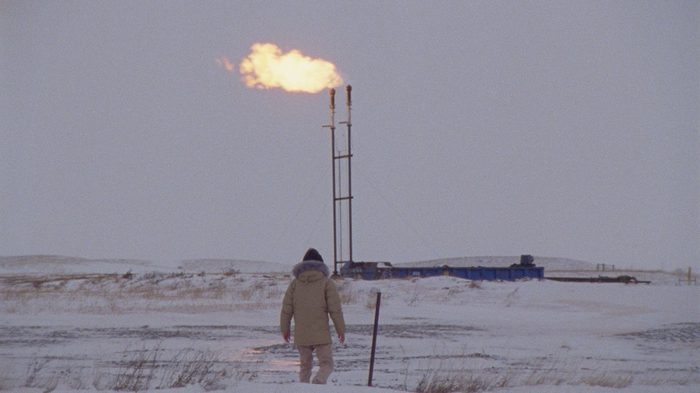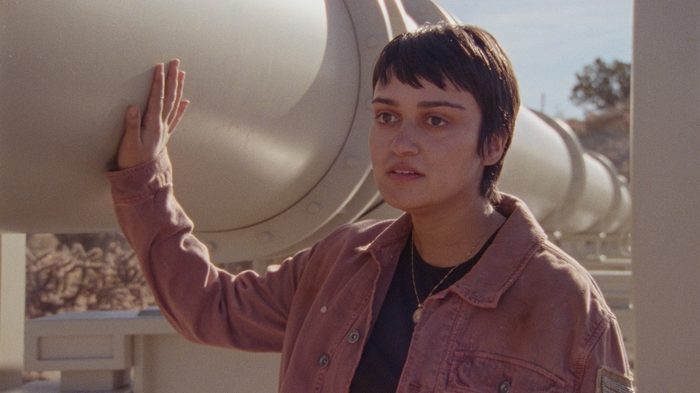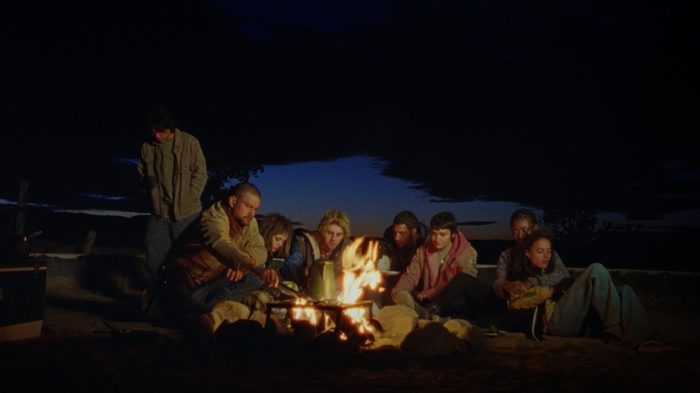Sabotage for the Planet?
A review of the “cool heist film” How to Blow Up a Pipeline.
Daniel Schindel

The endless brown of the West Texas desert is interrupted only by the monstrous white serpent of a pipeline. A group of twentysomethings work together to lift a homemade explosive (which, in a sign of dark irony, is housed within an oil drum) and secure it to the beast. One of the straps holding the bomb is fraying, and the group has already been spotted by a drone overhead. Every wasted second adds to the odds that they’ll be stopped.
These are the unambiguous heroes of How to Blow Up a Pipeline—a film that flips the script about how we’ve been conditioned to think about villains and heroes in these types of stories. But this isn’t an action movie based on a reactionary airport novel; this is a thriller based on a political manifesto.
When How to Blow Up a Pipeline was released as a nonfiction book in 2021, author Andreas Malm made the case that environmentalists have done themselves a disservice by so heavily emphasizing nonviolence. A core question seemed to be: If the future of the world and humanity are truly in jeopardy, why aren’t more people acting like it? Malm argues for the validity, efficacy and moral defensibility of sabotage and vandalism as tactics to impede fossil fuel infrastructure and make the current status quo impossible to maintain. He asserts that, at the very least, a wing of the environmental movement should take up more radical action. He is loath to even accept the framing of such actions as “violent,” given that they are done against structures rather than humans, but he concedes to the more common interpretation of the term. Even so, he insists that it is “different in kind” from violence against people, and much of the book is spent justifying its implementation.
Responses to the book ranged from approving to hostile, with some commentators criticizing Malm in no uncertain terms. Writing about Malm’s appearance on a New Yorker podcast, Lindsay Kornick, of Fox News, referred to him an “extremist” and quotes tweets by right-wing commentators condemning the magazine for “literally platforming a terrorist” and “soft endorsing terror acts.” Grayson Quay, at The Spectator, called Malm a “scofflaw” while grousing that “pro-lifers could never get away with” writing such a book.
Meanwhile, a few filmmakers were instead artistically inspired when they read the manifesto. As they explained in a Gawker interview, they started pursuing funding for a movie shortly after the book’s release. “Not a lot of movies about revolution in the climate movement exist at all,” says cowriter, actress and producer Ariela Barer. “Definitely not about young people resisting climate destruction.” Film editor Daniel Garber says conflict and humanity “naturally comes when you bring [eco-terrorism] into the real world,” with direct action offering the opportunity for a film to touch on “overlapping forces and scales of interpersonal relationships, and larger social and political relationships.”

Like so many similar issue-focused nonfiction books, the film project could have easily been a documentary — but director and cowriter Daniel Goldhaber, Barer, and the other producers weren’t documentarians. And they wanted a wider audience than documentaries typically draw. So, as Goldhaber puts it in one interview, they settled on a “cool heist film.” He shares screenwriting credit with Barer and Jordan Sjol.
In interviews about the film, the team cites influences like Ocean’s Eleven. They structured the movie to closely follow the conventions of the heist genre: a crew is assembled, they strategize their big score, and then complications emerge as they try to pull it off. But few heist films involve scenes of the characters meticulously constructing blasting caps, where one slip of the hand might blow them away. And if there’s a spy in the ranks, they work for the government, not a casino. Their goal isn’t a big score or some personal vendetta, but striking a blow for the future of Earth.
The movie starts with the group coming together to execute their plan. As they build their bombs, set them up on the pipeline, and plot their getaway, flashbacks dedicated to each character reveal backstories. The members of the motley crew come with disparate motivations, backgrounds and political inclinations. Leader Xochitl (Barer) is a passionate leftist activist fed up with the apparent inefficacy of her work and radicalized by the death of her mother in a Long Beach heat wave. Fellow activist Shawn (Marcus Scribner) is tired of doomscrolling on Twitter and wants to take concrete action to disrupt the oil industry. Xochitl’s best friend Theo (Sasha Lane) has cancer caused by local pollution, and because her diagnosis is terminal, she feels she has nothing to lose. Theo’s girlfriend Alisha (Jayme Lawson) is a gentler progressive who doesn’t agree with the plan, but goes along out of loyalty. Brooding Michael (Forrest Goodluck), who posts TikToks about bomb-making, has seen oil derricks encroach on his tribe’s lands in North Dakota and is itching to strike back. Unlike the rest of the group, Texan Dwayne (Jake Weary) is a conservative; he wants to stop the pipeline from being built on the land of his former family home, seized via eminent domain. Rowan (Kristine Froseth) and Logan (Lukas Gage) are Pacific Northwest anarchist punks seemingly in it for the fun.
Setting aside any ideological consideration, How to Blow Up a Pipeline is a well-executed action thriller. It economically balances its ensemble cast, all of whom get moments to shine, with each performer expertly suggesting a great depth of thought and backstory without having to say much. The production design also conveys a lot more than what is explicitly spelled out. The audience gets glimpses of most of the characters’ homes, with small decorative touches fleshing out their everyday lives. That all this was put together on a relatively low budget makes it even more impressive. And, drawing inspiration from the likes of classics like The Wages of Fear, the sequences of the construction and placing of the bombs are delightfully tense. It’s an almost elemental setup that Goldhaber, Garber and cinematographer Tehillah De Castro exploit with the same precision as the characters.
Despite its title, Malm’s book is not a how-to manual on pipeline infrastructure destruction. (In one scene from the film, Shawn peruses the book as Logan comments, “That’s got some good shit. Doesn’t teach you how to do it, though.”) The book is much more concerned with the “why” than the “how” of sabotage. In this sense, the film is less an adaptation than a sequel. Not much time is spent debating the ethics or morality of sabotage, because it’s primarily a suspense movie; the focus is the action. But the film does make room for some debate, which, as Goldhaber tells me during a post-screening conversation, “mirrors conversations that we [the filmmakers] were having amongst ourselves.”
These conversations are the parts that most resemble a direct adaptation of Malm’s work. Malm argues that protests organized by some climate justice groups see mass participation as the goal, even if they don’t move the needle on actual policy. Malm asks the reader to imagine waking up one day to discover that “regardless of all the strikes, the science, the pleas, the millions with colorful outfits and banners … the greasy wheels roll as fast as ever. What do we do then? Do we say that we’ve done what we could, tried the means at our disposal and failed? … Or is there another phase, beyond peaceful protest?”

One such conversation early in the film plays out that sentiment almost exactly, in dialogue form. At a meeting of campus activists calling for their college to divest from fossil fuels, Xochitl says, “I’m having trouble feeling like any of this matters.” The group’s leader admonishes her, insisting that divestment is important. Xochitl responds, “This would be great if we had time, but by the time any market solution does shit, billions of people will be dead.” The leader explains that “We all want faster change, but these are huge systems that change incrementally.”
Undeterred, Xochitl replies: “Right, so act outside of the system. We need to start attacking the things that are killing us.”
This scene leads into what becomes Xochitl’s mission statement (and the film’s promotional tagline): “This is an act of self-defense.” The group’s mission embodies the endpoint of Malm’s argument, which is that there is a need for the targeted destruction of fossil fuel infrastructure to disrupt its operation, to make the continuation of the status quo too costly for these companies and governments to ignore.
A later sequence similarly dramatizes arguments Malm makes to refute the nonviolent dogma of many traditional environmentalists. He devotes a large portion of the book to discrediting strict pacifism and those who categorize property destruction or even minor vandalism as “violence” and unconditionally disavow it as a tactic. While some nonviolent proponents point to the British suffragettes, the civil rights movement and the anti-Apartheid movement as examples to follow, the truth, Malm argues, is that all these movements had radical elements. The suffragettes favored “the argument of the broken pane” and engaged in hundreds of acts of property destruction. In a particularly apropos example, Malm notes the anti-Apartheid movement included targeting South African oil infrastructure for destruction, considering it the country’s “Achilles heel.”
As Malm puts it, “Strategic pacifism is sanitized history.”
In the film, some of the group debate whether they’re taking the best course of action and whether what they’re doing “counts” as terrorism. When Alisha (the member most resistant to the plan) takes issue with Shawn comparing what they’re doing to the civil rights movement, Shawn reminds everyone that Martin Luther King, Jr. was called a terrorist. Working off this, Xochitl rants, “Any time anyone has challenged authority, they call it terrorism. And then when the terrorism works, they lie about the legacy and say that it was all passive, nonviolent kumbaya shit, when it’s not.”
Michael ends the scene by deadpanning, “If the American empire calls us terrorists, then we’re doing something right.”
The film’s sympathies reframe the figure of the eco-terrorist. These are usually the cartoonish villains of Tom Clancy novels like Rainbow Six or James Bond films like Moonraker or Quantum of Solace. Even when their motivations are sympathetic — seen with everything from Aquaman to the Batman villain Poison Ivy — the works in question tsk-tsk any idea of acting beyond peaceful protest. Given how pop culture still treats fervent environmentalists as a punchline — even as the news around climate change grows increasingly dire — this film is a breath of fresh air. As we come closer to (or pass) points of no return with rising global temperatures, this kind of societal condescension becomes all the more alarming.
Even outside of big-budget filmmaking, there is queasiness around the idea of endorsing radicalism. Two independent films Goldhaber explicitly told me he wants to refute are The East and Night Moves, both of which are sympathetic to eco-terrorists but ultimately characterize them as “too extreme.”

This trend, of course, mirrors the severe punishment awaiting environmental protestors in the real world, even when they’re peaceful — as seen in everything from the crackdowns on Stop Cop City in Atlanta (with protesters charged with domestic terrorism on flimsy premises, to say nothing of the police shooting of Manuel “Tortuguita” Terán) to the wildly disproportionate charges leveled at people protesting Enbridge’s Line 3 pipeline in Minnesota. Malm is fully aware that an escalation of tactics would incur an even stronger response from the state, but he points out that the ceiling for these crackdowns is lowering by the year regardless, leaving activists with fewer “acceptable” options in any case.
Malm also defends the likes of Jessica Reznicek and Ruby Montoya (arrested and convicted for acts of arson against the Dakota Access Pipeline), who were ready to pay the price for their actions, and he also makes strategic suggestions for people to engage without getting caught. “Sabotage can proceed in the dark,” as he puts it.
In an interview, Goldhaber muses, “Every single movie about progressive action is a tragedy … there’s a subtly conservative notion running through all these stories, which amounts to ‘Don’t try, because you will fail.’” The makers of How to Blow Up a Pipeline wanted to tell a different story, one informed by the optimism and proactiveness Malm calls for in his book. As Barer puts it in another interview, they wanted to break the mold with “a movie about leftist politics where the group didn’t collapse in on itself in the process, or face some horrible consequences for their action.”
One could call the characters of How to Blow Up a Pipeline dangerous and naïve. One could also view them as some of the few people reacting appropriately to what’s at stake with the climate crisis.


